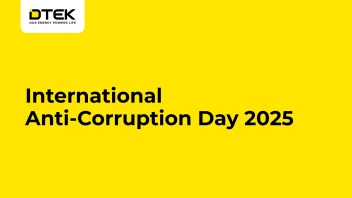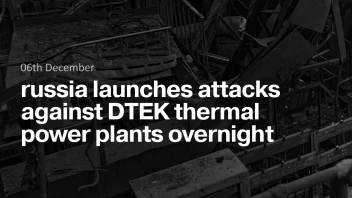Maxim Timchenko, DTEK's CEO, on coal stocks, restoration of power supply in blockaded cities and towns, and the impact of sanctions on the Putin's Russia.
Where were you when the war began?
Like most of the Kyivans, I was in my bedroom. I woke up at around 5 am from explosions. At 6 am, I had a call with the key members of the top management team, and at 7:30 am we met at our office in Unit.City.
Explosions outside were accompanied by Putin's statement declaring a war. After that our life changed.
On 24 February, the first day of war, you said that the energy sector had taken the first blow. 10 days have passed. How did they go?
We have already had a similar experience in 2014–2015 in the Donetsk and Luhansk regions. That is why at least we knew what should be our first steps. A relevant chain of command was built already in early February. We set up a task force at the corporate centre level and task forces at the operating holdings' level.
On Thursday, 24 February, we defined the key things that we need: communication, materials (from fuel to urgent materials to keep our facilities running) and the evacuation plan for our people. We changed the way we work and took fundamental decisions upon the market operation, utilisation of power plants, liquidity management, and partner relation management.
It took us three-four days to get our systems adjusted and key people relocated to the Western Ukraine, where we have our basic power plants: Burshtynska, Dobrotvirska and Zakhidenergo. Two weeks before these events, our vanguard team went there to set up communication and IT infrastructure, and now this is where our centre of command is.
How did the company re-calibrate its operation?
Everything is controlled by a single corporate centre. We put back a strict vertical chain of command in place. We maintain communication with our production companies, power plants, mines and network companies. There is a centralised control of the company's finance and centralised communication with the energy market, ministries etc.
How many personnel are staying to keep the system running?
Operating and technical personnel, primarily, of network companies remain on their workplaces. Their key task is to restore power supply. As for the rest, we are trying to evacuate them.
What is the situation in the regions?
Donetsk Grids: as of 5 March, power was cut to 118 communities, over 234 thousand customers. Overall, this is 18% of the total number of Donetsk Grids' customers. Our main struggle is Mariupol, which has been 100% without power for three days. Power is cut to 201,000 customers. If you multiply it by the number of people in a household, it means around 500,000 people without electricity. Our attempt to restore damaged substations failed as the ceasefire regime did not hold. Therefore, the entire city will be without power for another day.
In Odesa, Dnipro and Kyiv Grids (city), the situation is normal. In Kyiv Regional Grids (region), power has been cut to 358 communities, which is 157,000 customers or 16% of the total number of Kyiv Regional Grids' customers. It is mostly Hostomel and Bucha, which is where intense fighting is taking place.
Overall, power has been cut to 157,000 customers in the Kyiv region, which is around 450,000 people.
Our current losses reached USD 480 mln. Only the loss of Luhanska TPP is estimated to cost us USD 180,000 mln. Restoring the networks will cost about USD 50–70 mln.
What is the situation with your generating companies?
Majority of DTEK Energy's business divisions operate as normal except for Luhanska TPP, which has been under the Russian control since 25 February. We do not control this power plant, and it does not generate.
There is a complicated situation with Zaporizka TPP. It is difficult to bring coal there as the railways are damaged. Now it has about 37,000 tons of coal in stock, which will be enough for one unit to run for 10–15 days. The alternative is to use gas. Now we are working on a solution with the ministry that will allow us to burn gas in order to save coal.
It will work for all power plants except for Kurakhivska TPP. There are serious concerns that the impossibility to deliver coal or feed power into the grid will cause power plants in the Kharkiv region to shut down. Primarily, Zmiivska, Vuhlehirska and Slavinska Plants.
The main burden will be on our western power plants (Burshtynska and Dobrotvirska), which have now all their units in operation.
Pavlogradugol is running at full capacity. They even beat their coal production targets. This is our key mining group that the power grid's stability is dependent upon. If Pavlogradugol operates, Ukraine will have enough coal. The question is whether we will be able to deliver this coal.
By how much has gas production dropped?
By 10-12 %. Our usual daily production totalled 5.8 mcm of gas, today we produce only 5 mcm with condensate (by-product) being the main problem. The demand has significantly dropped. We sell it to those who stayed, transport to the storage facilities, give to the Army as a substitute for diesel fuel for armoured vehicles
"Green" generation?
Solar power plants work. Wind farms don't. Partially, because the power lines have been damaged and partially because the Russian military vehicles are located near the Botievo Wind Farm.
How do you estimate your Company's current losses?
Our current losses are USD 480 mln. Only the loss of Luhanska TPP is estimated to cost us USD 180,000 mln. Restoring the networks will require about USD 50–70 mln.
Russians are systematically destroying the critical infrastructure. How well is it protected?
In the first days, they did not intentionally target the critical infrastructure. Even strikes on CHPP-6 located in the Troieshchyna district (Kyiv) most likely were not an intentional attack. However, in the last three days the situation changed and targeted destruction started. A direct hit on the Okhtyrska CHPP in the Sumy region left nothing there. High voltage substations of Ukrenergo in Donetsk Region are also a targeted hit.
In terms of how well they are protected, it is a question to the military.
Is now the logistics the main problem?
The key problem is evacuation of people. Now the most difficult situation is in Volnovakha and Mariupol. We ensure evacuation of not only DTEK employees but all citizens of these towns. Today we put together bus convoy from all our nearby plants to evacuate people, but unfortunately, we have been unable to get them out so far (as of 5 March).
The second task is to maintain capacity on the power grid and fuel stocks at our power plants. After the Zaporizhzhia Nuclear Power Plant was captured, the capacity lost had to be compensated for. Yesterday (4 March), 23 units were in operation instead of 14 (nine additional units went online).
At the same time, we agreed with the Polish suppliers that 60,000 t of coal would be supplied. The problem is that now the coal prices are record high—USD 320–350/t. And the electricity tariff covers only USD 100/t.
We are closely working with the Ministry of Energy to avoid the physical and economic collapse.
And, of course, the priority is to quickly restore damaged networks. In 2014–2015, our repair crews had this experience. But if there is no access and permission from the military, they cannot do anything.
Do Russians give access to the captured facilities?
So far, not.
Electricity consumption has dropped by 35% and payments by 60–70%.
How was the access of your repair crews ensured in the ATO zone?
The Ceasefire Coordination Centre coordinated communication between the Ukrainian and Russian military. They gave the green light for our crews to work.
Now there is no such centre. Only the Ukrainian military give us permission for such works. The first efforts to establish a green corridor in Mariupol failed.
Is there any communication with Mariupol?
As far as it is possible. Currently, the general director of Donetsk Grids is there. Mobile communication is unstable.
We approached the Ministry of Digital Transformation and Elon Musk, asking to supply us up to 600 Starlink devices, and we are ready to pay for them. We are ready to give half of them to our colleagues from the energy sector so that the entire system has satellite communication.
How do you assess the stability of the energy system in general? How balanced is it?
The operation of the system is stable. Ukrenergo is working very well. There is enough coal, more than 700,000 tonnes in stock. There are reserves, but they depend on what happens next to the NPPs. The situation is currently under control.
How has the consumption mix changed?
No statistics available. Consumption has fallen by about 35% compared to the pre-war period due to the shutdown of steelmakers Metinvest and AMKR and lower consumption in the war-torn regions.
How much have payments dropped?
By 60–70%. We are trying to explain it. You cannot have the same deterioration of the payment discipline in the Dnipropetrovsk region, where the situation is more or less calm, as in the Donetsk region.
How are you balancing your economics?
I'll start with gas. We decided not to reduce our production. We are selling 70% of the pre-war volumes. The payment discipline is fine here. The rest is injected into the storages.
The situation with electricity is a major challenge for the entire energy system. Three times a day, the ministry holds a teleconference with all market players. There are various models that help ensure normal liquidity. We will not be able to do without governmental support. A direct injection of some part of the international financial aid, primarily, into state-owned companies is under discussion.
The level of sanctions is unprecedented. In fact, it is an economic war with Russia. The next step is an embargo on Russian energy products. Another step is to create a no-fly zone.
How is the company managing human resources?
There have been no layoffs. Of course, not everyone can physically work as some employees are in bomb shelters, some joined the territorial defence and so on. It is hard to provide accurate statistics. But everyone, regardless of their type of employment, remains on payroll. Besides, we paid salaries a week earlier than usual.
Further managerial decisions will be taken at the end of March when we have a clearer picture. I hope that the hostilities will end by that time.
Ukraine disconnected its energy system from Russia. How has the system performed in the island mode so far?
The transition to the island mode disconnected from Russia and Belarus had started before the military intervention began. This was a planned testing period (24–26 February) as part of the ENTSO-E synchronisation process. The second testing period was scheduled for the coming summer. Clearly, there will be no turning back.
We asked our Western partners to speed up synchronisation of the Ukrainian and European energy systems. It is highly likely that a decision to synchronise the two energy systems will be adopted as soon as next week as part of the military assistance.
What does it mean?
Before only the Burshtyn Island was synchronised with the European energy system, and now Ukraine’s entire energy system will be. We will get some 2,000 MW of power, which is equivalent to power generated by two nuclear units. Ukraine’s entire energy system currently consumes approximately 11,000 MW. That is potentially around 15% of our consumption may be met using power flows from Europe should we not have enough power.
Technically speaking, we are already able to work in this emergency support mode. We just need to complete the adjustment of certain settings to enable commercial operation in import/export mode. I believe we will be able to launch electricity exchange as soon as Q1 2023.
Energy sanctions against the Russian Federation. How painful are they and do Russians have any reserves to stand to them?
The level of sanctions is unprecedented. It is an economic war with Russia. The imposed sanctions effectively put this country outside of the global economy. One of the key tasks now is to phase out Russian gas supplies to Europe.
Embargo on Russian energy products must come as the next step. The second in line would be a no-fly zone.







